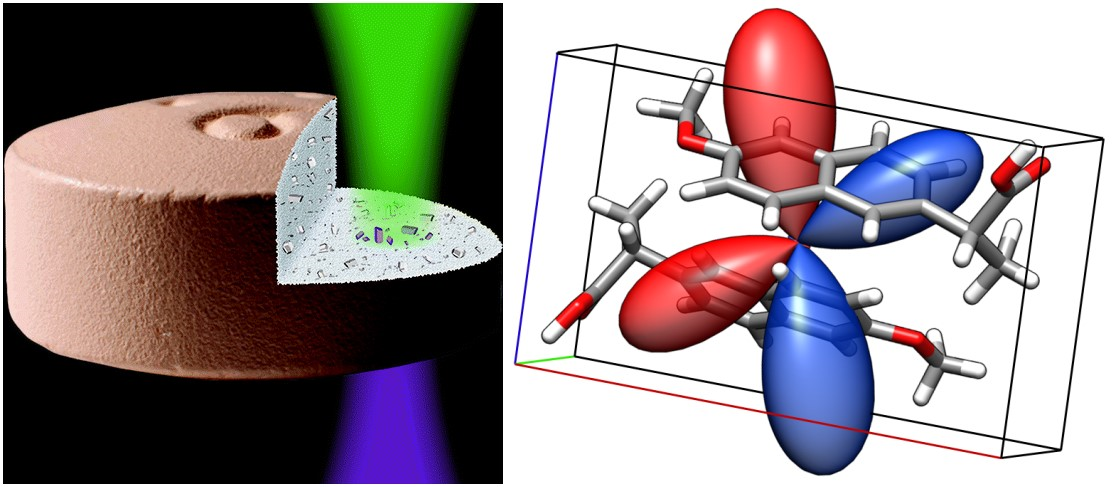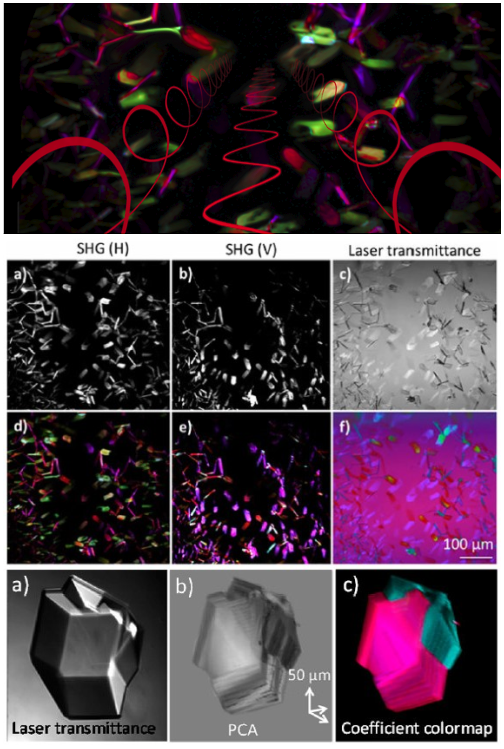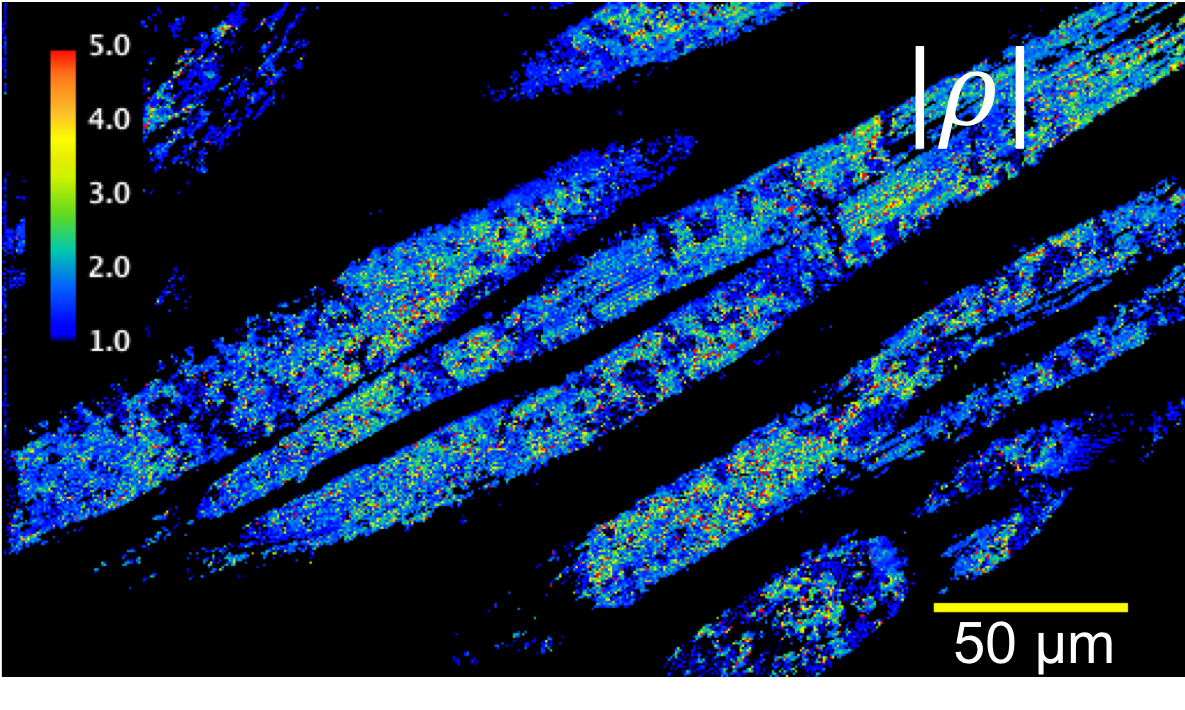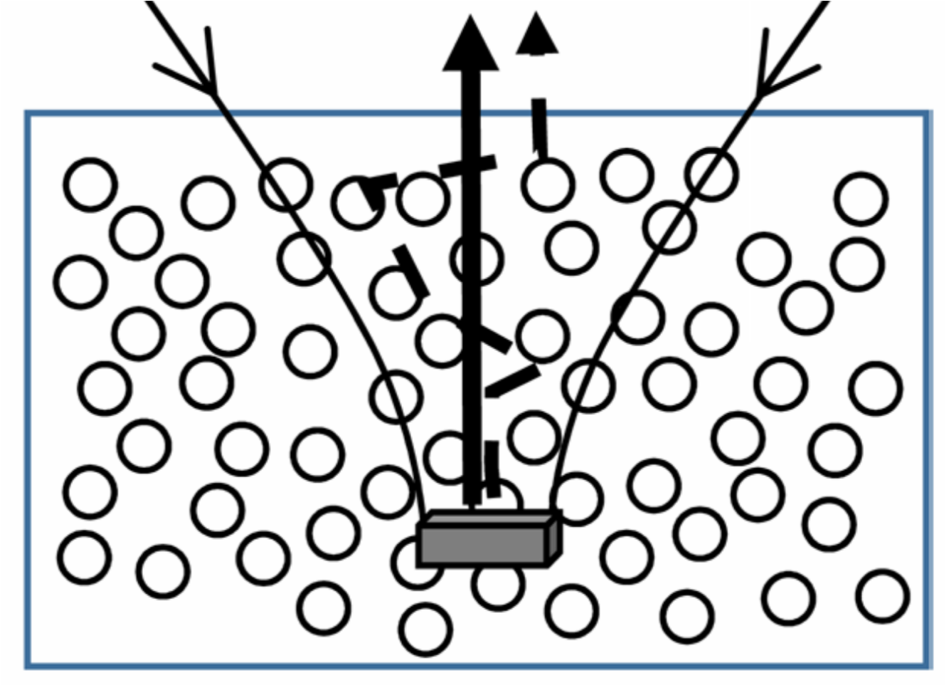Previous Research
Second Harmonic Generation Microscopy
Second order nonlinear optical effects, including second harmonic generation (SHG) and sum-frequency generation (SFG) enable image contrast directly tied to the local symmetry and molecular ordering in biological assemblies. We take advantage of both the overall intensity for image contrast and the exquisite sensitivity to polarization-dependence to characterize both structure and structural evolution in biological systems. Of particular interest are efforts to detect protein crystal formation to support macromolecular structure determination, small-molecule crystal formation of active pharmaceutical ingredients to support stability assessments, and tissue imaging to provide fundamental insights into native biopolymer organization. Additionally, we are using SHG microscopy to target subsequent measurement by Raman and synchrotron X-ray diffraction, combining the fast imaging capabilities of SHG with chemical information-rich orthogonal techniques.

Polarization-Dependent Imaging
The information content within an SHG measurement can be enhanced through polarization-dependent imaging. By modulating the incident polarization and measuring the intensity of the polarized output, structural characteristics of a sample can be recovered. Our current focus is using fast (8MHz) polarization modulation to enable video-rate polarization-dependent imaging. Such methodology could be used to rapidly characterize structure within many systems, potentially allowing such applications as disease monitoring in collagenous fibers, identification of twinning in crystals, or real-time discrimination of crystal polymorphic form.

A brief introduction of the instrument and algorithm development for nonlinear optical Stokes ellipsometric microscopy and its application in the analysis of pharmaceutical ingredients and biological tissues. Made by Dr. Ximeng You Dow for 2015 American Chemical Society meeting at Boston.
Triboluminescence
The pharmaceutical industry has become a victim of it's own rapid success. The improvement of drugs with respect to target specificity comes with a corresponding decrease in water solubility because of the increase of molecular complexity. The pharmaceutical industry is increasingly formulating it's active ingredients as amorphous solid dispersions (ASDs) to increase the apparent solubility. ASDs have their own problems, with the active ingredient being in it's amorphous form, it is thermodynamically favorable to recrystallize.
We are using Triboluminescence as a way to measure the crystallinity within amorphous solid dispersions. We have built a custom instrument to measure crystallinity with the help of the Jonathan Amy Facility for Chemical Instrumentation. Using this relatively inexpensive instrument we have demonstrated a limit of detection of 140 ppm, which is a large improvement over the 1-2% limit of detection for commonly used instruments (PXRD, DSC, ssNMR, etc.) For more information, please read our published article at Analytical Chemistry.
Mueller Tensors for Nonlinear Optics in Turbid Media
Turbidity and scattering can alter polarization state, introducing uncertainty in the measurement and interpretation of polarization-dependent optics. The Jones formalism for polarization-state analysis is incapable of representing the electric field with no defined polarization state and is thus insufficient as a formalism for interpretation of polarization-dependent measurements with significant contributions of intensity from unpolarized light. The Stokes-Mueller formalism is a more general approach to defining polarization of light via the field intensity, however it comes at a cost of greater complexity as the base vector for a single photon contains 4 elements, twice as large as the Jones vectors'. Recently, we developed a framework which connects the Jones framework directly to the Stokes framework, allowing predictive capacity for SHG behavior in the highly depolarized regime, such as when imaging thick tissue sections. This work leverages the community-wide usage of the simplest representation of the nonlinear optical susceptibility, the Jones tensor, while maintaining the generality of the Stokes framework. We have demonstrated the validity of the framework for interpretation of SHG polarization dependence from an unpolarized source, as measured by introducing a depolarizing optic into the Fourier plane of a beam-scanning microscope. Our theory agrees well for experimental determination of the polarization dependence of SHG from Z-cut quartz with a depolarized source. Furthermore, the depolarizing optic in the Fourier plane was also used as a method to recover orientation and tensor element magnitudes for thin collagenous tissue sections. Most recently, we have demonstrated the imaging of the unique tensor elements of collagen within a 40 µm thick section of mouse tail tendon.

